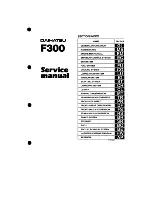
Rack Installation
Inadequately secured loads and incorrectly mounted roof racks and accessory
racks can come loose during travel and cause serious accidents! Therefore,
installation, handling and use must be carried out in accordance with product
and vehicle instructions.
In addition to these instructions, review the mounting instructions for the roof
rack and the operating instructions of the vehicle.
These instructions should be kept together with the vehicle’s operating
instructions and carried in the vehicle when in use and en route.
For your own safety, you should only use tested (e.g. GS-tested) roof racks that
are authorized for use with your vehicle.
For roof racks that do not specify the distance between the front and rear
crossbars, the distance shall be at least 700mm or as large as possible.
Please note that changes (e.g. additional drill holes) to the accessory rack’s
attachment system are not permissible.
Check attachment hardware and load for tight fit and function:
•
Before the start of any journey.
•
After driving a short distance (50km or 30 minutes) following rack or load
install.
•
At regular intervals on longer journeys.
•
Every two hours on bad terrain.
•
After interruption of a journey during which the vehicle was left
unsupervised. (check for damage due to outside intervention)
Rack Loading
Do not exceed the maximum load specified for the roof rack, accessory rack or
the maximum load recommended by the vehicle manufacturer.
Max Roof Load = weight of roof rack + weight of accessory racks +
weight of load.
The roof rack or accessory rack may not project over the gutter. For cars
without gutters over the outer edge, refer to StVZO (or nation regulations).
Load shall be uniformly distributed with the lowest possible center of gravity.
Load should not substantially extend beyond the loading surface of the roof
rack. refer to StVZO (or nation regulations).
Vehicle Driving and Regulations
The speed driven must be suited to the load transported and to official speed
limits. In the absence of any speed limits, we recommend a maximum speed
of 130 km/h.
When transporting any load, the speed of the vehicle must take into account
all conditions such as the state of the road, the surface of the road, traffic
conditions, wind, etc. Vehicle handling, cornering, braking and sensitivity to
side winds will change with the addition of roof top loads.
Off-road driving is not recommended and could result in damage to your
vehicle or your gear.
Maintenance
The accessory rack should be carefully cleaned and maintained, particularly
during the winter months. Use only a solution of water and standard car wash
liquid without any alcohol, bleach or ammonium additives.
For reasons of fuel economy and the safety of other road users, the accessory
rack and roof rack should be removed when not in use.
Periodically inspect accessory rack for damage. Replace lost, damaged or
worn parts. Use only original spare parts obtained from a stocking specialist,
dealer or manufacturer.
Any changes made to the roof racks and accessory racks as well as the use of
spare parts or accessories other than those supplied by the manufacturer will
lead to the lapsing of the manufacturer’s warranty and liability for any material
damage or accidents. You should observe these instructions to the letter and
only use the original parts supplied.
EN IMPORTANT WARNINGS
Choose premium roof racks now and transport your cargo safely and easily.






























